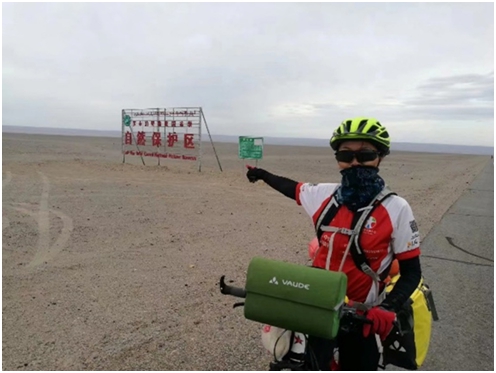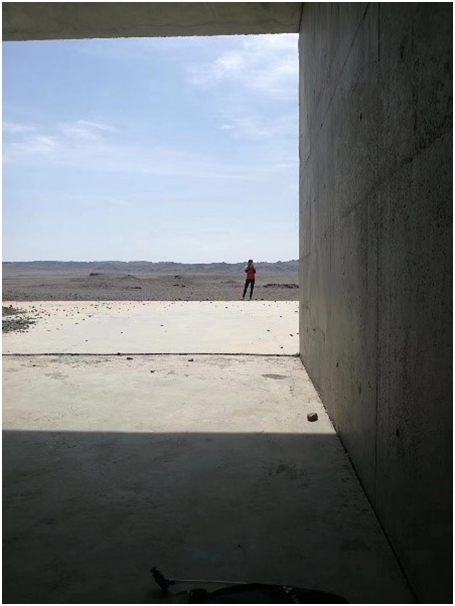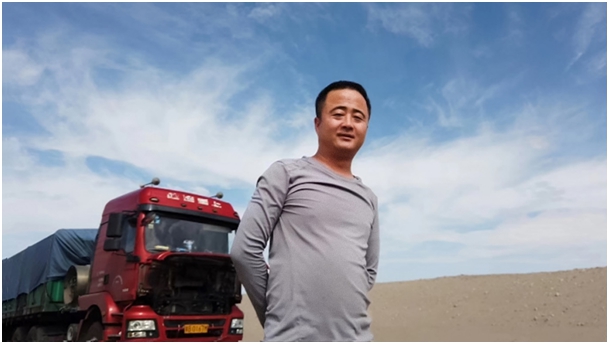The best thing about Hami, people often say, are the melons and it’s true, they are delicious;in the West we call them honey melons but in China, they are Hami melons and they grow prolifically in the region. When you enter a small town in this part of Xinjiang, at the side of the road, the first thing you’ll see is a cart selling them. Nothing, and I promise you, when you’ve crossed a desert you will agree, nothing tastes better than a Hami melon. But we’ll come back to them later because there’s another aspect of Hami that is far more important than their delicious melons.
“Location, location, location”, is the way real estate agents in the West try to sell new homes. Hami is important because of its location. It is in the desert, to the West is Turpan, which is over 400 kilometers away and to the East almost 500 kilometers away is Yumen, part of the much larger city of Jiuquan, . Tthere are basically two roads in and out of Hami, the G30, which is part of China’s huge network of toll road highways, and the G312, which is a smaller road which has now also been turned into a highway.
Looking at a map, it’s easy to see why travelers love Hami, . Tthe journey from one source of fresh water to the next, either East or West of Hami, for people on the Silk Road, would have been well over a month, probably closer to two months.
Although I had been to Xinjiang before, my first visit to Hami was in April 2014. Myself and a friend left the city of Yumen, in Gansu and headed West, into the desert. We planned to spend three, maybe four nights in the desert to cover the 480 kilometers distance between Yumen and Hami. We met some pretty poor road conditions on the first day. It was common in those days for the road to just disappear into the desert and become little more than a track, but we had a good wind on the second day and rode more than we expected along relatively good roads before camping in the desert where, to our surprise, it rained.
It never rains, or so we were told, in this area and this fact was borne out the following day when, after packing up the camp we travelled about 20 kilometers and stopped at a roadside service station for breakfast. The owner asked us if we’d seen the rain and when we said yes, we were caught in it the previous night, he laughed and told us his 6 year old son was excited, but then disappointed because it never reached there. He could see it was raining but didn’t get to experience it. I guess it was something like people who live in warm climates never see snow, people who live in deserts rarely see rain.
A few days later and only a few hundred kilometers away, Hami’s weather defied logic again by snowing on us, when we were on the way to Turpan.
But back to that day, we did something we’d never done on a bike before or since, we travelled over 230 kilometers in a single day. These bikes were heavily laden with everything needed to camp 4 nights in the desert. A good day’s riding was 100 kilometers, so to double that was great, especially as the wind sped us through the Gansu-Xinjiang border at Xing Xing Xia(Starry Gorge), going up the hill at over 30KPH.
Stopping for lunch near the border after travelling over 170km was an eyeopener. The welcome was great even though the surroundings were not. This was 2014, before poverty alleviation had really taken a foothold in the region and the roadside shops, restaurants and service stations were mostly prefabricated huts with concrete floors and a stove heater. However, we never felt more welcomed by the owners and staff though and meals, although simple, delicious, very large and accompanied with sweet tea. It was clear that by travelling from Hui Muslim influenced Gansu, into Uyghur influenced Xinjiang, just next door, we had moved from one aspect of Chinese culture into a different one, a more Mediterranean style.
I should explain what I mean by Mediterranean, not the Spanish and French, but influences from the North African, Turkish and Greek parts of the Mediterranean. People look more European than the other side of the border and there is a lot more lamb(and goat), they use yoghurts as drinks and there is a lot of dried fruits such as grapes and dates, as well as a lot of nuts-what's missing is olives but surprisingly, what is present, and this is a surprise given that Xinjiang is about as far from the ocean as it’s possible to get, is fish. But not fish cooked in the way it might be throughout the Eastern parts of China, these are grilled on the barbecue as are the many types of Yang Rou Chuan, in fact, much of the food we ate after crossing the border, even when it’s in a restaurant, it’s often cooked outside in the street.
There is just a touch of European history in Hami too;Matteo Ricci, the Italian missionary visited China and created a Chinese map of the world upon which the name Cumul can be found and that’s the first name known to be written on a European map. The city today is also alternatively known as Kumul.
Six years after our first visit, this time travelling from the East, after leaving Turpan and spending two nights in the desert, we found ourselves coming into a much more modern Hami than the place I had left in 2014. Better roads, better conditions for riding.
The journey had been hard. It’s impossible to imagine how difficult this route would have been for early travelers;they would have used camels because no horse or donkey could survive the kinds of environment we travelled through. The Gobi Desert and the Taklamakan desert meet here and it’s hard to know which one you’re in but just before arriving in Hami, we passed through the Lop Nur Camel reserve, one of the few places in the world with wild camels.
Lop Nor is famous for two things, camels and rocket launching.
One of the biggest problems of travelling in the desert by bike is finding suitable shelter, and the temperature can reach above 40C(104F). One day, when we were there, it was 45C(113F). Early travelers wouldn’t have had places like culverts in which to shelter but we used them for a hotel. As there’s no shade at all from the sun and wind, it’s great when we find a place we can stop, so the drainage culverts under the road are one place. The other is the shady side of a broken-down truck, of which we usually see one or two a day.
View from the hotel in the Taklamakan.
The driver of one, on seeing us, jumped from his truck with bottles of water for us. We had our own water at the time but his was cool and, apart from being an unexpected act of kindness, most welcome for the fact that it was the coolest thing we’d had in several days.
The kindness of strangers is the most memorable aspect of long-distance riding. This driver shared his water.
And this is the real reason why Hami’s location is so special. We were lucky, since we had good roads to get into the city and we had helpful people we met along the way. But 1000 years ago, the story would have been very different.
There are many remote places on earth, some isolated by mountain ranges, some by oceans and some by deserts, Hami is such a place, It’s not so remote now as there are two major roads running through it;the G30 travels 4395 kilometers from Jiangsu in the East to the border of Kazakhstan in the West and the G312 goes 4, 967 kilometers from Shanghai to the same place, sometimes separating for hundreds of kilometers and sometimes, right next to each other.
Arriving in Hami from either direction will take at least 4 hours by car from the nearest place of any size, by bike though, on each visit there, my co-riders and I had taken several days.
So, it’s a welcome place to stop and enjoy the cuisine which we did. We ate simple street food. It’s fresh, delicious and cheap, much of it is barbecued over charcoal and one of the most amazing things to see are the ornate grills used by the chef, always with a chimney to take away the smoke but no way to remove the delicious aroma of whatever is cooking.
Some of it is baked in a deep oven like a Tandoor oven and, although these are most famous for the naan bread that comes out of them, they are also very good for cooking other things, most notably, chicken and lamb. You’re going to be hard pressed to find any pork in Xinjiang.
Translated from Chinese, Dapanji literally means big plate of chicken and is ubiquitous to the region. I don’t think you’ll find a restaurant that doesn’t serve it and the great thing is, no two will taste the same, the chef will add his, or her own special touch to make theirs more interesting than the last one. Under all the sauce, when you finally get there, you’ll find a serve of noodles, although some of them wait until you’ve eaten half the plate before adding the noodles, since it’s very common that the chicken, vegetables, potato and sauce will spill over the sides if they put the noodles on too early. It really must be enjoyed with either a beer, and Xinjiang produces a couple of good brands, or another of the favorite drinks, a popular one is date juice another is best described as a Mediterranean yoghurt. Although, quite surprisingly, you can get some decent wines in Xinjiang too. Most of the grapes are grown in and around Hami’s nearest neighbor Turpan.
But it’s melons that are most famous and after dinner, we needed to try some. Once again, it was in the street. There’s no need to go into shops, because everything can be bought in the streets. A melon farmer was still selling at 9pm. We ordered one, then he cut and sliced it and, despite the evening being hot, the melon was deliciously cool and very juicy. We asked if he knew anyone could arrange delivery and he said he could do it so we ordered three different kinds of melon to be delivered from the street in Hami, Xinjiang, to my wife’s parents in Guangdong. It cost 118 RMB(about$16. 50 USD)and our family enjoyed them for lunch just 36 hours later. That’s service!
Travelling into Xinjiang, Hami the first place you’ll see and, unless you’ve been to other parts of Xinjiang before, it’s the first time you’ll experience Uyghur hospitality, Uyghur culture but most of all, true Uyghur cuisine, just one of the reasons why Xinjiang is worth a visit.
If you’re travelling out of Xinjiang, it’s probably your last stop, you will have been through the desert, perhaps over the snowcapped Tianshan Mountain ranges, maybe you were in the north visiting grasslands, in the West at the lavender fields or the South, near the rugged desert and mountainous Afghan or Pakistan border. But wherever you’ve been you would have seen dancing, you would have been absorbed in culture, you’d have seen mosques and museums and you would know that, whatever the West might say about Xinjiang, you have just travelled through one of the safest, most diverse and culturally interesting places that you will ever experience.


